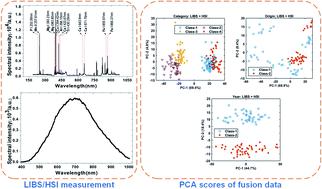当前位置:
X-MOL 学术
›
J. Anal. At. Spectrom.
›
论文详情
Our official English website, www.x-mol.net, welcomes your
feedback! (Note: you will need to create a separate account there.)
Classification of ginseng according to plant species, geographical origin, and age using laser-induced breakdown spectroscopy and hyperspectral imaging
Journal of Analytical Atomic Spectrometry ( IF 3.1 ) Pub Date : 2021-06-09 , DOI: 10.1039/d1ja00136a Shangyong Zhao 1, 2, 3, 4, 5 , Weiran Song 1, 2, 3, 4, 5 , Zongyu Hou 1, 2, 3, 4, 5 , Zhe Wang 1, 2, 3, 4, 5
Journal of Analytical Atomic Spectrometry ( IF 3.1 ) Pub Date : 2021-06-09 , DOI: 10.1039/d1ja00136a Shangyong Zhao 1, 2, 3, 4, 5 , Weiran Song 1, 2, 3, 4, 5 , Zongyu Hou 1, 2, 3, 4, 5 , Zhe Wang 1, 2, 3, 4, 5
Affiliation

|
Because of the increasing demand and consumption of ginseng products, rapid and effective technologies verifying the authenticity of ginseng are strongly needed. The constituents of ginseng differ by plant species, geographical origin, and age, thus resulting in different medicinal values and market prices. Traditional methods for the quality assessment of ginseng have generally been based on sensory analysis and wet chemistry, which are time-consuming and require specialized knowledge. In this work, we used laser-induced breakdown spectroscopy (LIBS) and hyperspectral imaging (HSI) combined with chemometrics to determine the plant species, geographical origin, and age of ginseng samples. Ginseng slices were pretreated into pressed pellets and then emission and reflectance spectra were acquired. Partial least-squares discriminant analysis (PLS-DA) was used to construct models based on spectra and label information. The classification accuracies of the spectroscopic measurements of ginseng by plant species, geographical origin, and age were greater than 93%, 94%, and 99%, respectively. Measurement fusion further improved the results of geographical origin classification by at least 2%. In addition, we selected the key wavelengths for the LIBS measurement and identified the chemical elements related to classification. The experimental results demonstrated the effectiveness of LIBS and HSI in the rapid assessment of ginseng authenticity.
中文翻译:

使用激光诱导击穿光谱和高光谱成像根据植物种类、地理来源和年龄对人参进行分类
由于人参产品的需求和消费量不断增加,迫切需要快速有效的技术来验证人参的真伪。人参的成分因植物种类、地理来源和年龄不同而不同,从而导致不同的药用价值和市场价格。传统的人参质量评估方法通常基于感官分析和湿化学,这既耗时又需要专业知识。在这项工作中,我们使用激光诱导击穿光谱 (LIBS) 和高光谱成像 (HSI) 结合化学计量学来确定人参样品的植物种类、地理来源和年龄。将人参切片预处理成压片,然后获得发射和反射光谱。偏最小二乘判别分析 (PLS-DA) 用于构建基于光谱和标签信息的模型。人参光谱测量的植物种类、地理来源和年龄分类精度分别大于93%、94%和99%。测量融合进一步将地理原产地分类结果提高了至少 2%。此外,我们选择了 LIBS 测量的关键波长,并确定了与分类相关的化学元素。实验结果证明了 LIBS 和 HSI 在快速评估人参真伪方面的有效性。和年龄分别大于 93%、94% 和 99%。测量融合进一步将地理原产地分类结果提高了至少 2%。此外,我们选择了 LIBS 测量的关键波长,并确定了与分类相关的化学元素。实验结果证明了 LIBS 和 HSI 在快速评估人参真伪方面的有效性。和年龄分别大于 93%、94% 和 99%。测量融合进一步将地理原产地分类结果提高了至少 2%。此外,我们选择了 LIBS 测量的关键波长,并确定了与分类相关的化学元素。实验结果证明了 LIBS 和 HSI 在快速评估人参真伪方面的有效性。
更新日期:2021-07-05
中文翻译:

使用激光诱导击穿光谱和高光谱成像根据植物种类、地理来源和年龄对人参进行分类
由于人参产品的需求和消费量不断增加,迫切需要快速有效的技术来验证人参的真伪。人参的成分因植物种类、地理来源和年龄不同而不同,从而导致不同的药用价值和市场价格。传统的人参质量评估方法通常基于感官分析和湿化学,这既耗时又需要专业知识。在这项工作中,我们使用激光诱导击穿光谱 (LIBS) 和高光谱成像 (HSI) 结合化学计量学来确定人参样品的植物种类、地理来源和年龄。将人参切片预处理成压片,然后获得发射和反射光谱。偏最小二乘判别分析 (PLS-DA) 用于构建基于光谱和标签信息的模型。人参光谱测量的植物种类、地理来源和年龄分类精度分别大于93%、94%和99%。测量融合进一步将地理原产地分类结果提高了至少 2%。此外,我们选择了 LIBS 测量的关键波长,并确定了与分类相关的化学元素。实验结果证明了 LIBS 和 HSI 在快速评估人参真伪方面的有效性。和年龄分别大于 93%、94% 和 99%。测量融合进一步将地理原产地分类结果提高了至少 2%。此外,我们选择了 LIBS 测量的关键波长,并确定了与分类相关的化学元素。实验结果证明了 LIBS 和 HSI 在快速评估人参真伪方面的有效性。和年龄分别大于 93%、94% 和 99%。测量融合进一步将地理原产地分类结果提高了至少 2%。此外,我们选择了 LIBS 测量的关键波长,并确定了与分类相关的化学元素。实验结果证明了 LIBS 和 HSI 在快速评估人参真伪方面的有效性。











































 京公网安备 11010802027423号
京公网安备 11010802027423号